The AMD Ryzen Threadripper 1950X and 1920X Review: CPUs on Steroids
by Ian Cutress on August 10, 2017 9:00 AM ESTShadow of Mordor
The next title in our testing is a battle of system performance with the open world action-adventure title, Middle Earth: Shadow of Mordor (SoM for short). Produced by Monolith and using the LithTech Jupiter EX engine and numerous detail add-ons, SoM goes for detail and complexity. The main story itself was written by the same writer as Red Dead Redemption, and it received Zero Punctuation’s Game of The Year in 2014.
A 2014 game is fairly old to be testing now, however SoM has a stable code and player base, and can still stress a PC down to the ones and zeroes. At the time, SoM was unique, offering a dynamic screen resolution setting allowing users to render at high resolutions that are then scaled down to the monitor. This form of natural oversampling was designed to let the user experience a truer vision of what the developers wanted, assuming you had the graphics hardware to power it but had a sub-4K monitor.
The title has an in-game benchmark, for which we run with an automated script implement the graphics settings, select the benchmark, and parse the frame-time output which is dumped on the drive. The graphics settings include standard options such as Graphical Quality, Lighting, Mesh, Motion Blur, Shadow Quality, Textures, Vegetation Range, Depth of Field, Transparency and Tessellation. There are standard presets as well.
We run the benchmark at 1080p and a native 4K, using our 4K monitors, at the Ultra preset. Results are averaged across four runs and we report the average frame rate, 99th percentile frame rate, and time under analysis.
All of our benchmark results can also be found in our benchmark engine, Bench.
MSI GTX 1080 Gaming 8G Performance
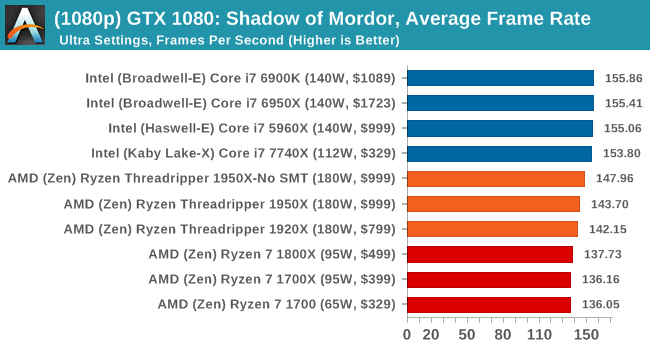
1080p


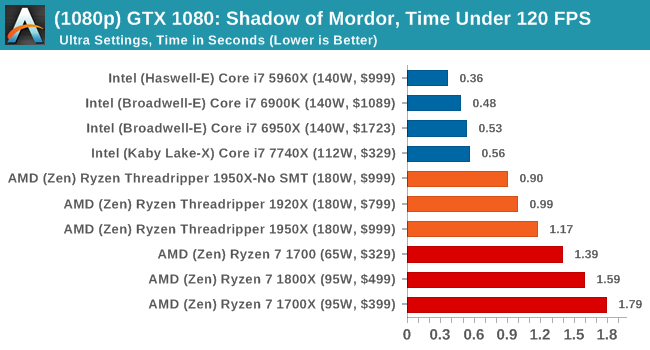
4K
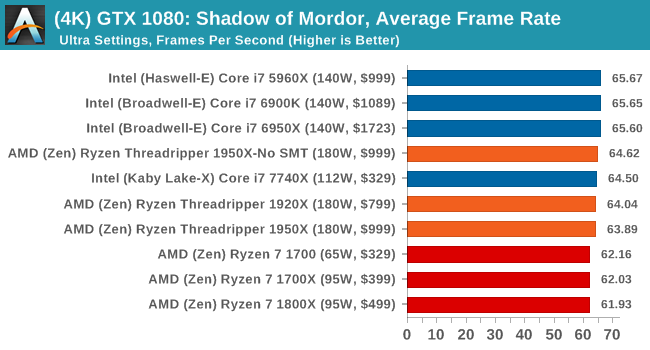
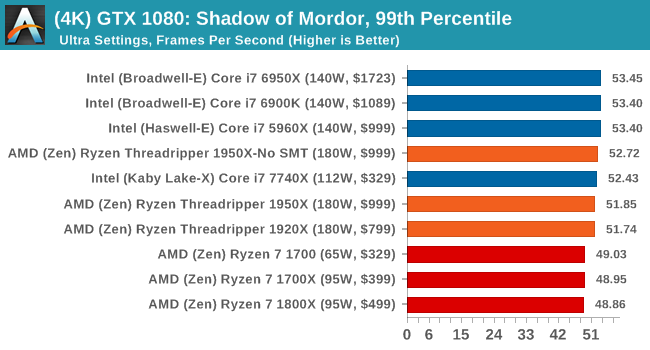
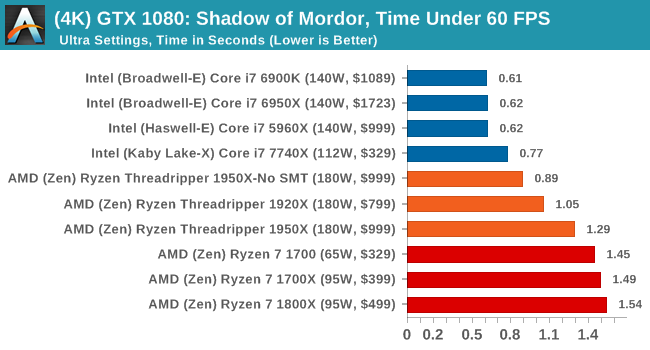
ASUS GTX 1060 Strix 6G Performance
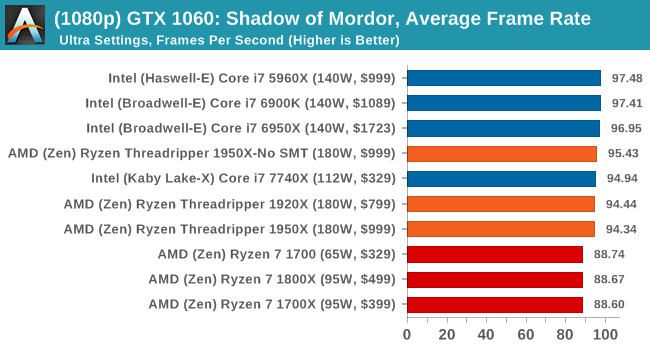
1080p

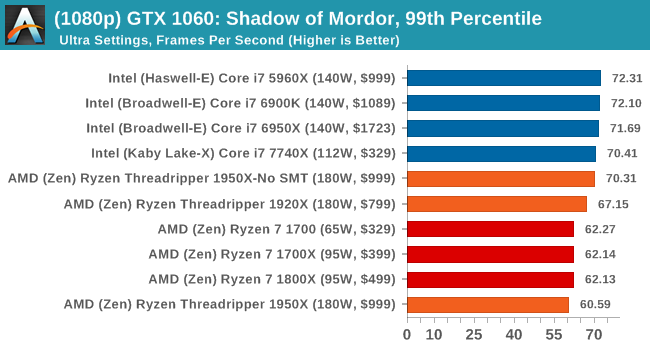
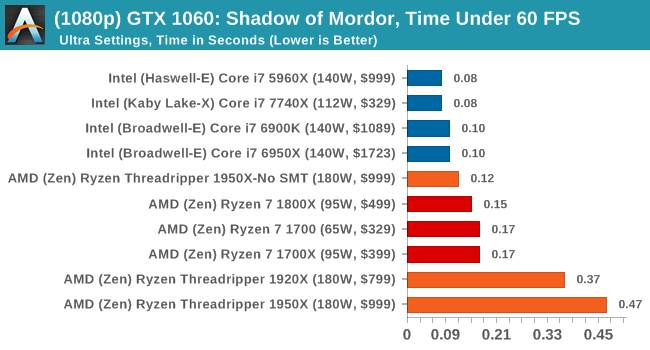
4K
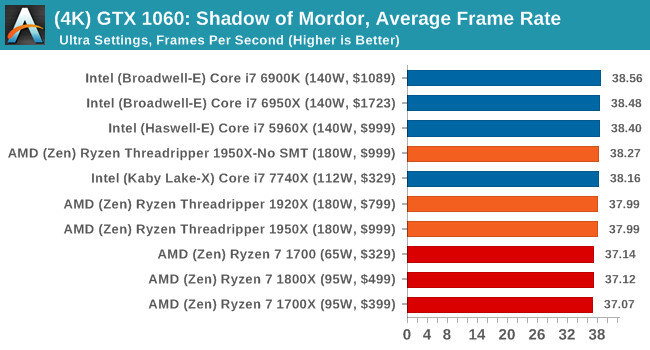
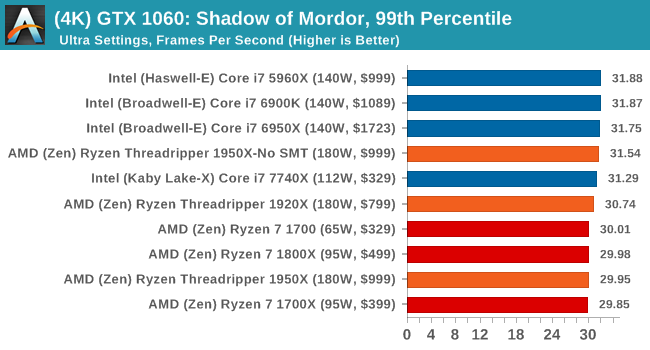
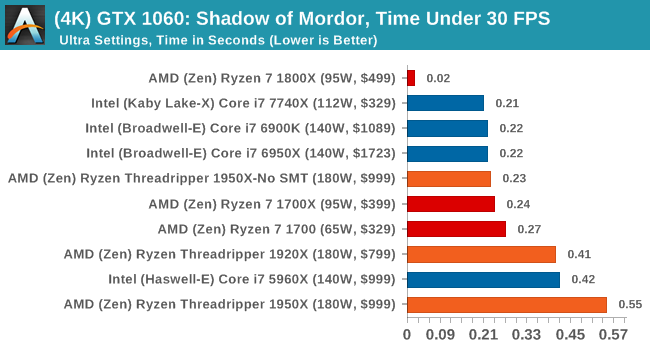
Sapphire Nitro R9 Fury 4G Performance
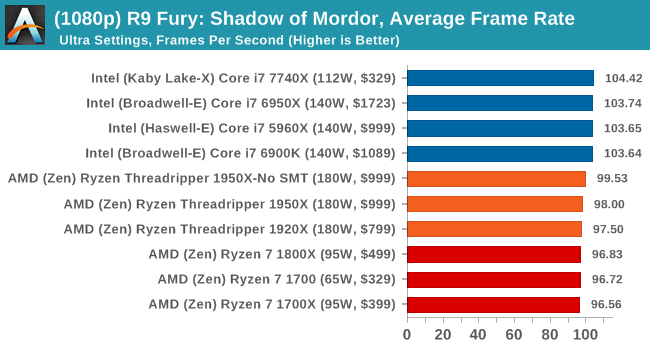
1080p


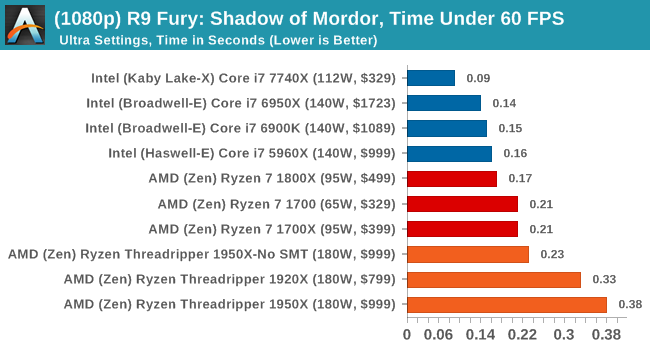
4K
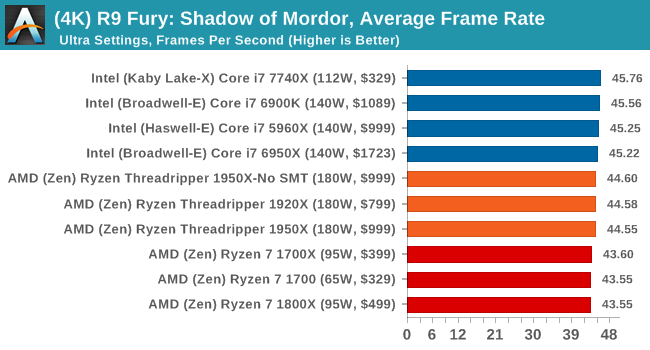

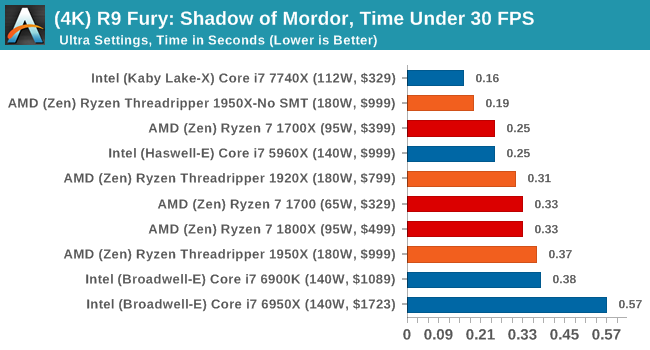
Sapphire Nitro RX 480 8G Performance
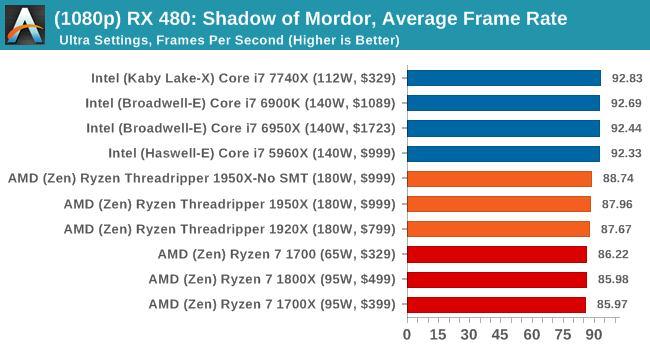
1080p


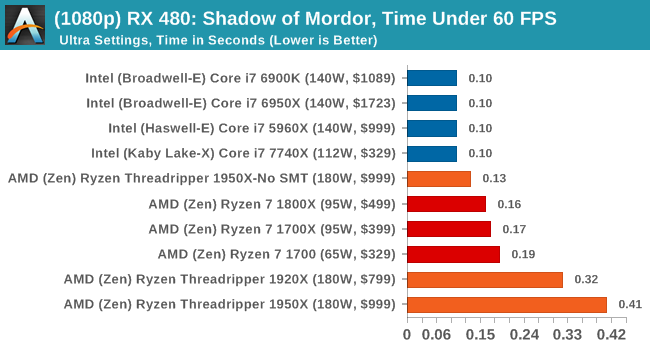
4K

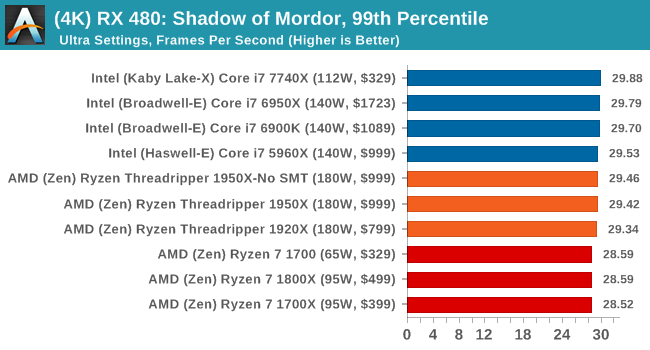



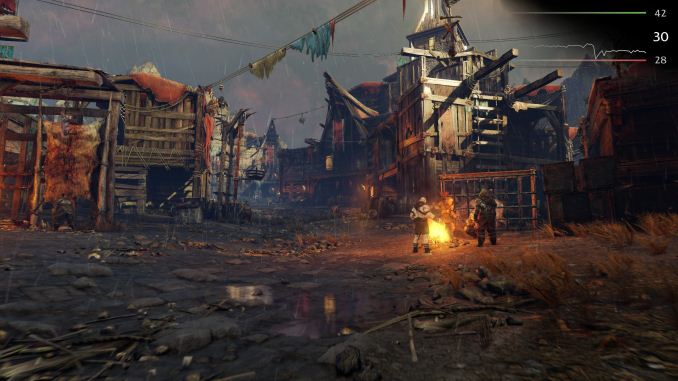
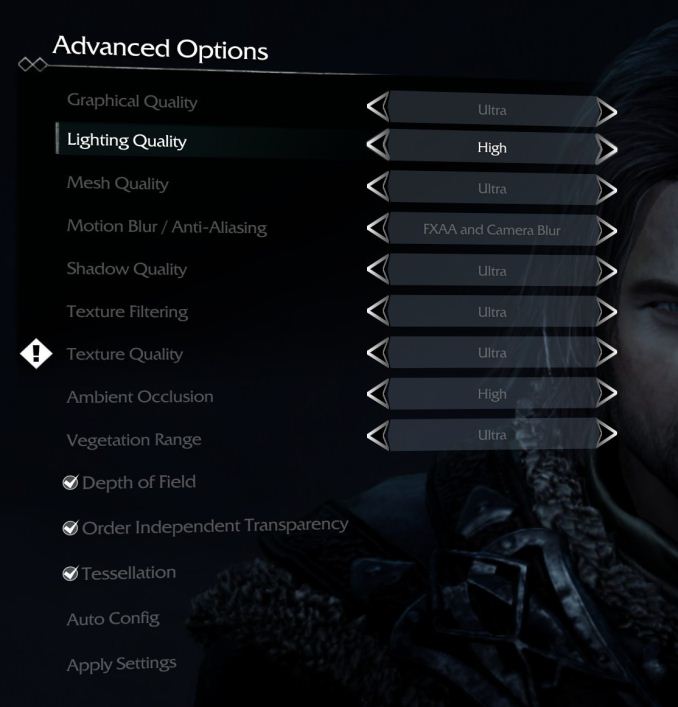








347 Comments
View All Comments
Vorl - Thursday, August 10, 2017 - link
the answer to both of you is that "this is a High end PC processor, not a workstation CPU, and not a server CPU. That was clearly covered at the start of the article.If you want raw number crunching info, there will be other sites that are going to have those reviews, and really, maybe anandtech will review it in that light since it really is such a powerful CPU in another review for server stuff.
Also, there is a LOT of value in having a standardized set of tests. Even if a few tests here and there are no longer valuable like PDF opening, the same tests being used across the board are important for BENCH. you can't compare products if you aren't using the same tools.
Unfortunately AMD is ahead of the curve currently with massive SMP being given to normal consumers now at a reasonable price. It will take a little time for dev's to catch up and really make use of this amazing CPU.
With the processing power in a CPU like this imagine the game mechanics that can be created and used, For those of us that are more interested in making this a reasonably priced workstation/server build for VMs etc, cool for us, but that isn't where this is being marketed, and it's not really fair to jump all over the reviewer for it.
Zstream - Thursday, August 10, 2017 - link
Utter rubbish. This CPU is designed for a workstation build. Some a product labeled Xeon is a workstation CPU, but this isn't?mapesdhs - Friday, August 11, 2017 - link
Yeah, TR doesn't really look like something that's massively aimed at gamers, it has too many capabilities and features which gamers wouldn't be interested in.pm9819 - Friday, August 18, 2017 - link
AMD themselves call it a consumer cpu. Is Intel paying them as wellLolimaster - Friday, August 11, 2017 - link
It's a HEDT/workstation, a year ago people called Workstation a dual Xeon 8 cores, which a sole 1950X replicates.Intel draws a line not supporting ECC, AMD supports ECC in all their main cpu's server or not all the way back to Athlon 64.
16cores/32threads, ECC, 64 pci-e lanes, upgrade path to 32cores/64threads with zen3. Smells Workstation to me.
Another thing is server cpu's which EPYC is, with features tailored to it, like a massive core count with low clock speeds to maximize efficiency and damn expensive mobos without any gamerish gizmo, just think to put on building without looking at net. TR can do a bit of that too, but optimized to an all around performance and budget friendly.
Ian Cutress - Thursday, August 10, 2017 - link
Dan sums it up. Some of these tests are simply check boxes - is it adequate enough.Some people do say that an automated suite isn't the way to do things: unfortunately without spending over two months designing this script I wouldn't have time for nearly as much data or to test nearly as many CPUs. Automation is a key aspect to testing, and I've spent a good while making sure tests like our Chromium Compile can be process consistent across systems.
There's always scope to add more tests (my scripts are modular now), if they can be repeatable and deterministic, but also easy to understand in how they are set up. Feel free to reach out via email if you have suggestions.
Johan Steyn - Thursday, August 10, 2017 - link
Ian, I understand that you see them as checkboxes, but this is not a normal CPU John doe is going to buy. It has a very specific audience and I feel you are missing that audience badly. I guy that buys this to use for rendering or 3Dstudio Max, is not going to worry about games. Yes, it would be a great bonus to also be OK at it. Other sittes even did tests of running rendering as well as play games at the same time. TR shined like a star against Intel. This is actually something that might happen in real life. A guy could begin a render and then while waiting, decide to play a game.I would not buy TR to open pdf's, would I?
Ian Cutress - Thursday, August 10, 2017 - link
No, but you open things like IDEs and Premiere. A PDF test is a gateway test in that regard with an abnormally large input. When a workstation is not crunching hard, it's being used to navigate through programs with perhaps the web and documents in tow where the UX is going to be indicative of something like PDF opening.Lolimaster - Friday, August 11, 2017 - link
Including useless benchs not only you waste target audience time, you too having to write and upload images from that useless benchs instead of making the article more interesting.How about a "the destroyer for HEDT/Workstion", a typical productivy load + some gaming, out of a sudden people will get TWICE the cpu resources, they can do things they couldn't before on the same machine.
They could get a dual socket mobo with 2x10c Xeons paying the hefty premium with pathetic clock speeds if they wante to game a bit while doing work, TR fixed that, with mass consumer type of gaming performance while reducing the multicore costs by more than half (cores counts + ECC support without paying intel tax).
Lolimaster - Friday, August 11, 2017 - link
And that audience few months ago was limited to do their productivity thing with 6-8 cores or 10 paying the huge intel tax, probably they couldn't game without hurting other things and had a 2 secondary PC for killing time.With TR and the massive 16 core count they can finally do all of that off a single PC or focus the entire powerhorse when they need (leaving things do work during their sleep).